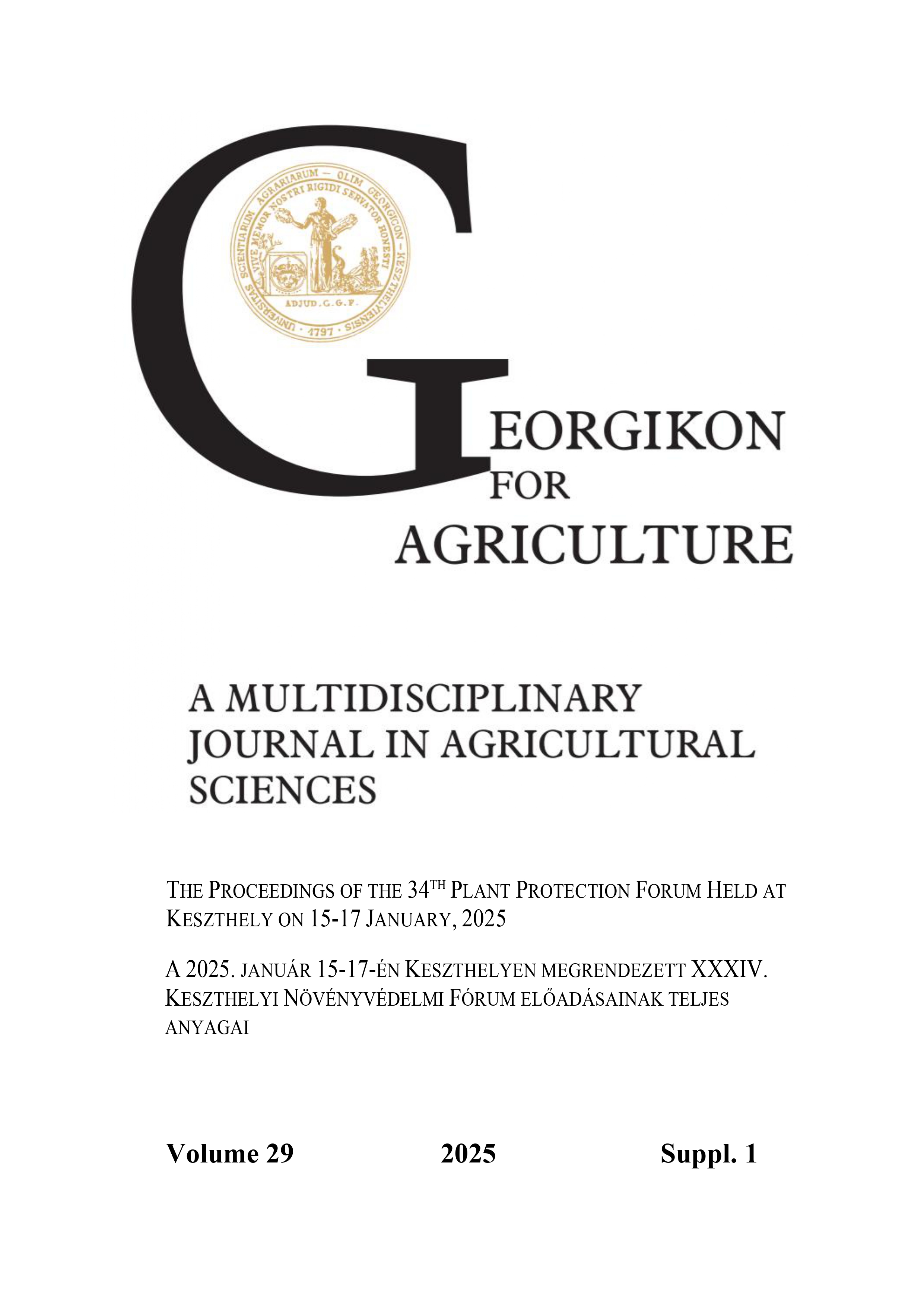Virological survey of walk-in plastic tunnel grown pepper seedlings and forced pepper varieties in Western Hungary in 2023-2024
DOI:
https://doi.org/10.70809/6576Keywords:
Capsicum annuum, pepper, virus, RT-PCR, resistanceAbstract
Peppers can be infected by approximately 50 plant viruses of which the most common species causing significant economic losses in Hungary are Potato virus Y (PVY) and Cucumber mosaic virus (CMV) in outdoor cultivation and Tomato spotted wilt virus (TSWV) and tobamoviruses in indoor cultivation. In addition to vectors’ activity, the infected propagating material also plays a very important role in the spread of pepper infecting viruses. Thus, besides the use of virus-free propagating material and effective protection against vectors, the cultivation of virus-resistant varieties and application of hygiene regulations are essential in the control of pepper viruses. Even with the most precise cultivation techniques, virus infections can occur during indoor cultivation, not only in plantations which are already producing but also in seedling nurseries, therefore monitoring these is crucial to achieve virus-free fruiting pepper stand. In 2023–2024, virological survey of pepper seedlings and fruiting plants collected from two horticultural farms in Zala county and grown in walk-in plastic tunnel was performed using RT-PCR technique to test leaf and fruit samples. During the analysis only the presence of TSWV was identified in 13 samples, while infection of CMV, PVY and tobamoviruses was not detected. It is interesting to highlight that TSWV was detected, despite the black necrosis that developed, in the fruits of the TSWV resistance gene carrying pepper cultivars Antal F1 and Zalkod F1.These results indicate that the use of TSWV resistant pepper varieties or hybrids does not provide complete protection against TSWV damage as symptoms may also appear on resistant individuals not only on susceptible ones due to the vectors’ activity. Therefore, monitoring the vectors that can transmit TSWV and timely control them are essential for indoor pepper cultivation. Without these even TSWV resistant plants will not be able to produce marketable crop.
References
Barboza, G. E. and Bianchetti, L. B. 2005. Three new species of Capsicum (Solanaceae) and key to the wild species from Brazil. Systematic Botany. 30 (4) 863–871. https://doi.org/10.1600/036364405775097905
Balázs S. 1994. A zöldségtermesztők kézikönyve. Mezőgazda Kiadó, Budapest.
Edwardson, J. R. and Christie, R. G. 1997. Viruses infecting peppers and other solanaceous crops Volume 2. University of Florida Agricultural experiment Station, Institute of Food and Agricultural Sciences, 766 pp.
FAO 2024. https://www.fao.org/land-water/databases-and-software/crop-information/pepper/fr/, Letöltés dátuma 2024. 02. 29.
Kálmán, D., Palkovics, L. and Gáborjányi, R. 2001. Serological, pathological and molecular characterisation of Hungarian Pepper mild mottle tobamovirus (PMMoV) isolates. Acta Phytopathologica et Entomologica Hungarica. 36 (1–2) 31–42. https://doi.org/10.1556/APhyt.36.2001.1-2.4
KSH 2024. https://www.ksh.hu/stadat_files/mez/hu/mez0024.html, Letöltés dátuma 2024. 02. 29.
Li, J., Yang, P., Kang, J., Gan, Y., Yu, J., Calderón-Urrea, A., Lyu, J., Zhang, G., Feng, Z. and Xie, J. 2016. Transcriptome analysis of pepper (Capsicum annuum) revealed a role of 24-epibrassinolide in response to chilling. Fronters in Plant Science. 7 1281. https://doi.org/10.3389/fpls.2016.01281
Nemes, K. and Salánki, K. 2020. A multiplex RT-PCR assay for the simultaneous detection of prevalent viruses infecting pepper (Capsicum annuum L.). Journal of Virological Methods. 278 113838. https://doi.org/10.1016/j.jviromet.2020.113838
Sáray R., Pinczés D., Salánki K., Bulecza Cs, Csilléry G. and Almási A. 2021. Szentesen üvegházban termesztett paprikaminták virológiai vizsgálata a 2019-2021 közötti időszakban. Növényvédelem. 82 (57) 453–459.
Sáray R., Szathmáry E., Pinczér D., Almási A., Deák T., Salánki K. és Palkovics L. 2022. Szőlő Ponit gris vírus (Grapevine Pinot gris virus, GPGV) fertőzöttség egy dél-magyarországi szőlőültetvényben. Növényvédelem. 58 (10) 429‒436.
Takácsné H. M. 2017. Zöldségtermesztés I. Debreceni Egyetemi Kiadó, Debrecen.
Tóbiás I., Salánki K., Almási A., Timár Z., Palkovics L. és Csilléry G. 2014. Rezisztencia források keresése a paprika TSWV rezisztenciát áttörő törzsével szemben. pp. 449–453. In: Veisz O. (szerk.) Növénynemesítés a megújuló mezőgazdaságban, XX. Növénynemesítési Tudományos Nap, Budapest, Magyarország.
Wang, H, Wu, X, Huang, X, Wei, S, Lu, Z and Ye, J. 2022. Seed Transmission of Tomato Spotted Wilt Orthotospovirus in Peppers. Viruses. 14 (9) 1873. https://doi.org/10.3390/v14091873
Whitfield, A. E., Ullmann, D. E. and German, T. L. 2005. Tospovirus-thrips interactions. Annual Review of Phytopathology. 43 459–489. https://doi.org/10.1146/annurev.phyto.43.040204.140017
Xu, Q., Wen, X. and Deng, X. 2004. A simple protocol for isolating genomic DNA from chestnut rose (Rosa roxburghii tratt) for RFLP and PCR analyses. Plant Molecular Biology Reporter. 22 301–302. https://doi.org/10.1007/BF02773140
Downloads
Published
Issue
Section
License
Copyright (c) 2025 Szathmáry Erzsébet, Szendrei Lilla, Fehér Dorina

This work is licensed under a Creative Commons Attribution-NonCommercial-NoDerivatives 4.0 International License.
Cikkre a Creative Commons 4.0 standard licenc alábbi típusa vonatkozik: CC-BY-NC-ND-4.0. Ennek értelmében a mű szabadon másolható, terjeszthető, bemutatható és előadható, azonban nem használható fel kereskedelmi célokra (NC), továbbá nem módosítható és nem készíthető belőle átdolgozás, származékos mű (ND). A licenc alapján a szerző vagy a jogosult által meghatározott módon fel kell tüntetni a szerző nevét és a szerzői mű címét (BY).




